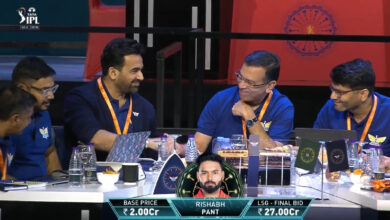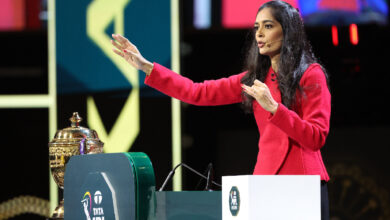Virat Kohli must pass stiffer tests to establish ‘greatness’; James Anderson has a point

Being a country that loves to dote on its heroes and icons to the extent to putting them on a pedestal reserved for divinity, we would brook no ‘disregard’ to our heroes.
Therefore, when England bowler James Anderson chose to go against the grain and play down the ‘genius’ of Virat Kohli, the country rose up in arms almost in unison.
Asked what had changed in Kohli’s technique on a day the Indian captain pulverised the England bowlers scoring a career-best 235 in the fourth Test at Mumbai, Anderson said, “I am not sure if he (Kohli) has changed. I just think any technical deficiencies he has got are not in play out here. The wickets just take that out of the equation. There is not that pace in the wicket to get the nicks, like we did against him in England – with a bit more movement.”
Virat Kohli acknowledges the cheers of the crowd on Day 4 of the fourth Test against England in Mumbai.
“When that (pace and movement) is not there, he (Kohli) is very much suited to playing in these conditions. He is a very good player of spin – and if you are not bang on the money and don’t take your chances, he will punish you,” the veteran pacer added.
“Sacrilege!” cried the Indian public. “How could he?” others wondered. The comment was variously construed as either a case of sour grapes, or a clever ploy of playing mind games, and India’s lead spinner Ravichandran Ashwin reportedly gave Anderson a piece of his mind on the field for his remarks, while Kohli himself refused to read too much into the comments and urged Anderson to “move on”.
Even the president of the Board of Control for Cricket in India (BCCI), Anurag Thakur, jumped into the fray, likening Anderson to an angry cat scratching a pillar, having lost its prey (“Khisiyani billi khamba noche”).
The issue also had former players such as Inzamam-ul-Haq and Kapil Dev weighing in, refuting Anderson’s claims.
But rather than creating such a hullabaloo, wouldn’t it have made better sense to pause and think, even for a moment, if there was some merit in Anderson’s views? After all, faith should be always born out of a critical analysis, and not blindly accorded.
Kohli has had a phenomenal year, across formats. He simply could not put a foot wrong in 2016, setting one record after another, putting each and every bowler he faced to the sword. He has already amassed 640 runs in the ongoing Test series against England and with the sparkling 235 at the Wankhede, notched up three double tons in three consecutive series.
This year, he has scored 1,200 runs in 17 innings in Tests, with four centuries (three of them double centuries) and two fifties; 739 runs in 10 ODIs, with three centuries and four fifties, and 641 runs in 14 T20I innings. He had often bailed out his team when the chips were down, for instance against Pakistan in the Asia Cup, or in the second innings of the Rajkot Test against England. Those innings were worth their weight in gold, even though they were no half centuries.
Between all that, he set the Indian Premier League (IPL) on fire scoring a surreal 973 runs with four centuries, taking his side to the final when all seemed lost. Listing all the records the star has set would be beyond the scope of this article, but it is widely held that 2016 has been the year of Virat Kohli, one would think. But was it actually? Let’s play the Devil’s Advocate, shall we?
The big question, if you look at Kohli’s batting figures this year, that comes to mind is: have the Tests been test enough for Kohli? People have been going gaga over his double tons against the West Indies, New Zealand and England in consecutive series. As much as he deserves credit for those knocks and as much as it is a fact that he had a job to do for India, the conditions were not the most trying that he would ever face, nor did the bowling attacks threaten life and limb.
Add to that the fact that the New Zealand and England series have been played at home, on favourable pitches. He has proved himself to be an able player of spin – something that even Anderson acknowledged – and against average spinners, and pacers rendered toothless on pitches that hardly offered assistance, Kohli, one feels, has had an easy ride.
In fact, a look at Kohli’s Test career would tell you that he hasn’t got the better of top quality bowlers on difficult wickets on a consistent basis. The emphasis here is on consistency. The first time that he toured Australia in 2011-’12, he could score only 300 runs in eight innings, that too against an Australian attack that was nowhere near as menacing during much of the noughties. He has played only two Tests each in South Africa and New Zealand, though he scored a hundred in both those tours, plus a ninety against the Proteas.
But in 2014, he had one of the most forgettable tours of his career in England, with scores of 1, 8, 25, 0, 39, 28, 0, 7, 6 and 20. This tally of 134 runs in 10 innings would have been scoffed at by even a tailender.
In that series, Kohli’s technical flaws were indeed exposed, with him repeatedly nicking deliveries outside the off stump. Kohli had a torrid time against the England pacers and was dismissed on all but one occasion by the pacers in that series, with Anderson accounting for his wicket four times. The length of the series – played over five Tests – was a rigorous test of Kohli’s abilities against world class seam bowling in conditions that aided pace and movement.
Kohli had a far better outing in Australia later that season, scoring four hundreds in four Tests, against the likes of Mitchell Johnson and Mitchell Starc, which showed he was improving.
This turnaround of sorts reminded one of the way Rahul Dravid revived his ODI career, which didn’t have the greatest of starts. Dravid made his ODI debut in 1996, but could not live up to the huge expectations on him in the initial part of his ODI career and was dropped in 1998. A strike rate of around 64 in 65 matches gave the impression that he was not being able to grasp the concept of ODI cricket, and was adequate reason for his omission. However, he reinvented himself, identified his role in the side as a sheet anchor and became one of the mainstays of the Indian batting. In fact, the same Dravid, who people said could not score quickly enough, made a 22-ball 50 against New Zealand at Hyderabad in 2003.
Kohli would have to fine tune his game to be at ease against top bowlers, on pitches that suit pace and movement, the way Dravid adjusted his game to the needs of ODI cricket. He has had a tendency to reach out and push at deliveries outside the off stump, playing away from his body, which makes him susceptible to the balls moving away. He has to address this “technical deficiency”, in Anderson’s words. The tour Down Under in 2014-’15 showed that the process is underway in right earnest.
Therefore it is difficult to agree with Anderson that Kohli’s technique hasn’t improved at all, but it is a fact that a proper test of his abilities would be against pace, bounce and movement, and who better to take that test than Anderson himself, who has mastered the art of swing bowling, has over 400 Test wickets, and is without a doubt one of the best bowlers of his generation? That test will take place when India tours England next, and Kohli would want to prove Anderson wrong.
It is also a fact that subcontinent pitches haven’t provided adequate challenge to Kohli’s batting, nor have the opposition he has been playing against lately. Kohli has proved himself against spin, but you have to pass through fire to be counted as gold and the greatest challenge for Kohli in order to establish himself as one of the ‘greats’ of the game will be to tame pace, bounce and movement, facing up to the Andersons of the world.







